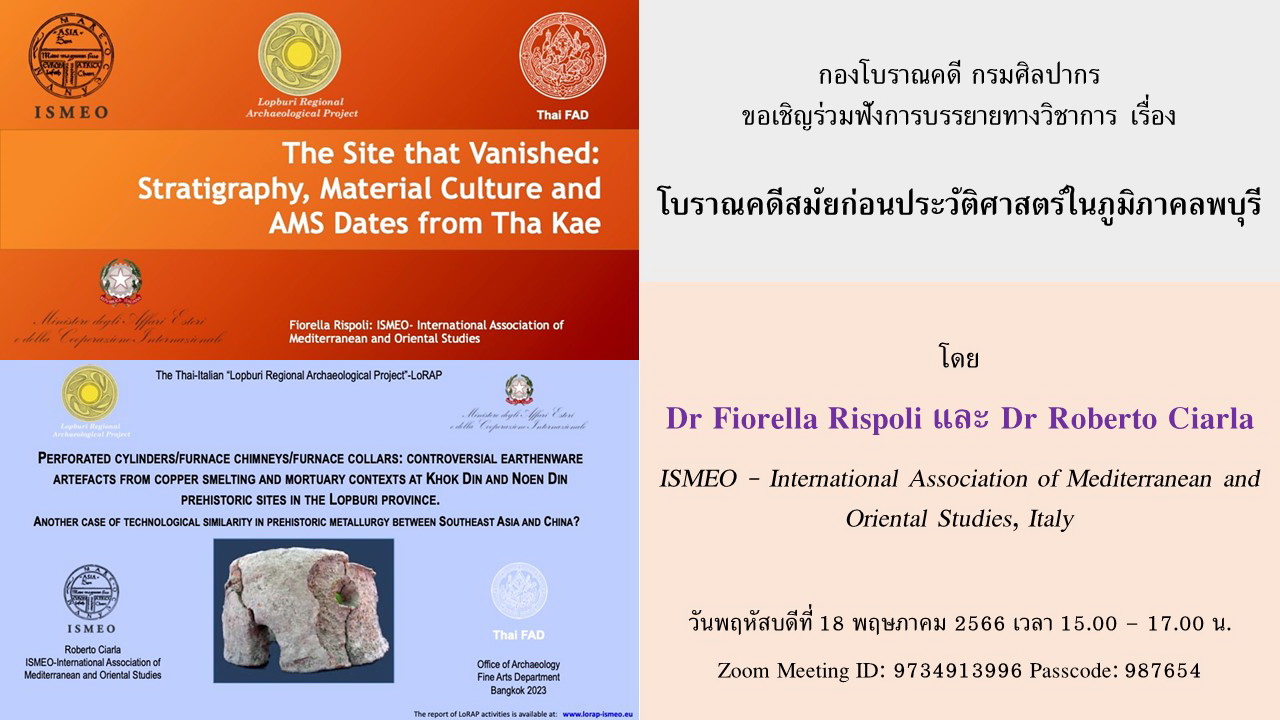ขอเชิญร่วมฟังการบรรยายทางวิชาการ “โบราณคดีสมัยก่อนประวัติศาสตร์ในภูมิภาคลพบุรี” ผ่านสื่ออิเล็กทรอนิกส์โปรแกรม Zoom

กรมศิลปากร โดยกองโบราณคดี จัดการบรรยายทางวิชาการ เรื่อง “โบราณคดีสมัยก่อนประวัติศาสตร์ในภูมิภาคลพบุรี” วิทยากรโดย Dr Fiorella Rispoli และ Dr Roberto Ciarla นักโบราณคดีผู้ดำเนินโครงการ Lop Buri Regional Archaeological Porject จากสถาบัน ISMEO – International Association of Mediterranean and Oriental Studies ประเทศอิตาลี ให้แก่นักโบราณคดีสังกัดกรมศิลปากรและผู้สนใจ
การบรรยายประกอบด้วย ๒ หัวข้อ ได้แก่ การบรรยาย หัวข้อ “The Site that Vanished: Stratigraphy, Artefacts and AMS Dating from Tha Kae” โดย Dr Fiorella Rispoli และการบรรยาย หัวข้อ “Perforated Cylinders/Furnace Chimneys/Furnace Collars: Controversial Earthenware Artefacts from Copper Smelting and Mortuary Contexts at Khok Din and Noen Din Prehistoric Sites in the Lopburi Province. Another Case of Technological Similarity in Prehistoric Metallurgy Between Southeast Asia and China?” โดย Dr Roberto Ciarla
ขอเชิญชวนผู้สนใจร่วมฟังการบรรยายทางวิชาการ เรื่อง “โบราณคดีสมัยก่อนประวัติศาสตร์ในภูมิภาคลพบุรี” ผ่านสื่ออิเล็กทรอนิกส์โปรแกรมซูม (Meeting ID: 9734913996 Passcode: 987654) ในวันพฤหัสบดีที่ 18 พฤษภาคม 2566 เวลา 15.00 – 17.00 น. สอบถามเพิ่มเติมได้ที่กลุ่มวิจัยและพัฒนางานโบราณคดี กองโบราณคดี โทร. 0 2164 2523
---------------------------------------------
+หัวข้อการบรรยายและบทคัดย่อ+

Title: The Site that Vanished: Stratigraphy, Artefacts and AMS Dating from Tha Kae.
Author: Dr Fiorella Rispoli
Author: Dr Fiorella Rispoli
Abstract:
Tha Kae doesn't need a long introduction: it was among the largest, pre- and proto-historic moated-sites in central Thailand. In early aerial photos of the 40s and 50s it is possible to appreciate its original shape and size before the construction of the Chainat-Pasak irrigation canal that irreversibly damaged the western side of the site. Its “hidden wealth”, the caliche terrace on which the site developed over ca. three millennia, was also its downfall: its original structure was tragically destroyed by intensive quarrying for the extraction of carbonate soil for local construction, beginning in the 50s. At Tha Kae the bulldozers cut through the deposit creating long “sections” where Neolithic and Iron Age grave-cuts stood out. In following years, the site was also the subject of intensive looting. When we arrived 1987, not much remained of the site, but some intact "islands" could still yield archaeological data for the reconstruction of this large site's chronological/cultural sequence. It was not an easy task, but we accepted the challenge. In 2020-2021, due to travel restrictions, we were permitted to use part of our field funds granted to our project for AMS dating. Part of the samples (mainly charcoal), from reliable contexts, provided AMS dates that can only be considered as termini post quem due to their built-in age. However, even so these dates support what is proposed herein in this critical review of Tha Kae's stratigraphy and cultural sequence. Other dates, in particular those from bivalve shells and shell beads from graves, returned the most reliable dates, in agreement with the 14C of many other sites in Thailand.
The results of this latest (as far as we are concerned, definitive) analysis of the chronological-cultural sequence of Tha Kae is presented, including previous and new radiometric dating results.

Title: Perforated Cylinders/Furnace Chimneys/Furnace Collars: Controversial Earthenware Artefacts from Copper Smelting and Mortuary Contexts at Khok Din and Noen Din Prehistoric Sites in the Lopburi Province. Another Case of Technological Similarity in Prehistoric Metallurgy Between Southeast Asia and China?
Author: Dr Roberto Ciarla
Abstract:
The Thai-Italian “Lopburi Regional Archaeological Project” excavated different types of technical ceramics at the prehistoric sites of Khok Din (KD) and Noen Din (ND) (late 1st millennium BCE-early 1st millennium CE) near the copper bearing Khao Sai On (KSO) inselberg (Ban Nikhom 3 sub-district, Changwat Lopburi). A particular type of technical ceramic -called in different times and publications ‘perforated cylinder’, ‘furnace chimney’, ‘furnace collar’- is examined describing its contexts of discovery and peculiar techno-typological characteristics. At KD and ND we assume these artefacts were introduced in the metallurgical tool-kit between 200 BCE-200 CE. At both sites, the fragments of FC are associated with crucible fragments, gangue, bits of copper ores and slag. The uncontaminated stratigraphic evidence provides an additional piece of information to the hypothesis that crucibles and ‘FCs’ can be directly associated with the reduction of copper ores. Typological and functional comparisons are examined at the regional level with homologous materials the Thai-American Thailand Archaeometallurgy Project (TAP) excavated at mortuary and copper smelting sites (mid-to-late 1st millennium BCE-early 1st millennium CE) in the Khao Wong Prachan Valley (KWPV) (central Thailand), and, at the inter-regional level, with similar artefacts found at copper smelting sites (13th-11th centuries BCE) nearby Niuheliang in Liaoning Province (Northeast China). Should we look North again for a technological innovation (in Thailand so far only documented in the KSO and KWPV sites) introduced in central Thailand by local metallurgists a millennium later than the Liaoning evidence? Whether or not is a matter of future research, wishing for new discoveries in Thailand from some of our younger Thai colleagues.
(จำนวนผู้เข้าชม 1281 ครั้ง)
สงวนลิขสิทธิ์ © 2563 กรมศิลปากร. กระทรวงวัฒนธรรม
-
นโยบายเว็บไซต์ |
มาตรฐาน |
นโยบายการคุ้มครองข้อมูลส่วนบุคคล
 เว็บท่ากรมศิลปากร
เว็บท่ากรมศิลปากร
